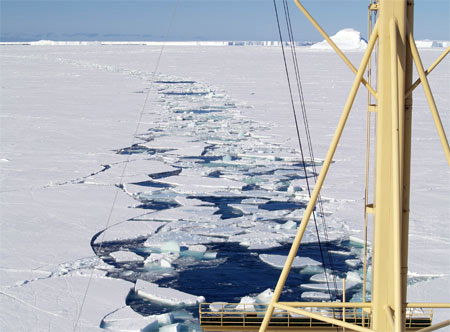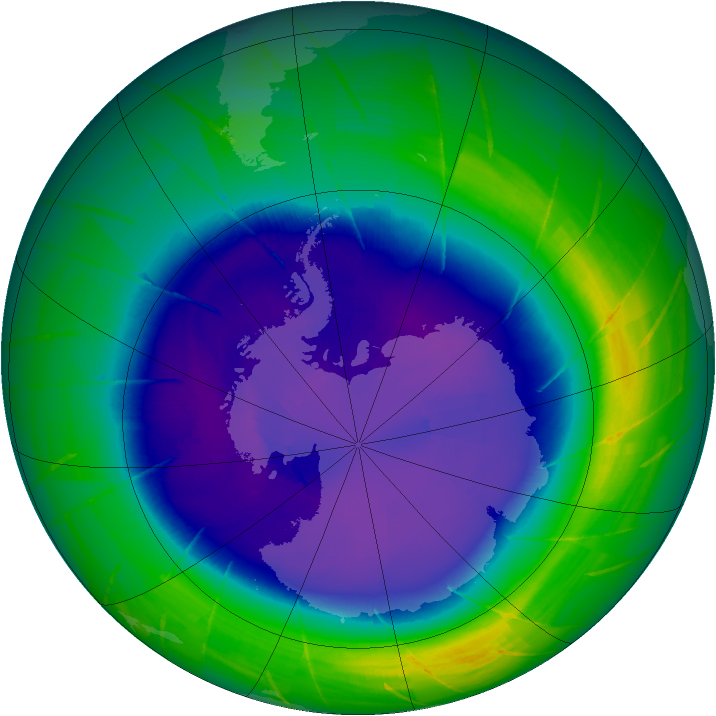SCAR top tenScience editors boil report down to list of major findingsPosted December 18, 2009
The Antarctic Climate Change and the Environment (ACCE) The hole in the ozone layer has shielded most of Antarctica from global warming. The ozone hole has delayed the effect of greenhouse gas increases on the climate of the continent. South polar winds (the polar vortex) have intensified and altered Antarctic weather patterns, causing westerly winds over the Southern Ocean that surrounds Antarctica to increase by about 15 percent. The stronger winds have effectively isolated Antarctica from the warming elsewhere on the planet. As a result, during the past 30 years there has been little change in surface temperature over much of the vast Antarctic continent, although West Antarctica has warmed slightly. An important exception is the eastern coast of the Antarctic Peninsula, which has seen rapid summer warming. This warming is caused by stronger westerly winds bringing warm, wet air into the region from the ocean. Warming of the Southern Ocean will cause changes in Antarctic ecosystem The largest ocean current on Earth, the Antarctic Circumpolar Current, has warmed faster than the global ocean as a whole. The Southern Ocean is one of the major sinks of atmospheric CO2, but increasing westerly winds have affected the ocean’s ability to absorb CO2 by causing the upwelling, or rising, of CO2 rich water. If temperatures continue to rise, “alien” species may migrate into the region, competing with and replacing original Antarctic inhabitants. Key species in the food chain like planktonic (free-floating) snails could suffer from ocean acidification, another consequence of higher concentrations of CO2 in the atmosphere. Changes in the food regime are likely to decrease the rich Antarctic seabed biodiversity. Rapid increase in plant communities across the Antarctic Peninsula Rapid warming along the western Antarctic Peninsula, combined with a switch from snowfall to rain during summer, has caused plant, animal and microbial communities to expand in newly available land. Humans have also inadvertently introduced “alien” organisms such as grasses, flies and bacteria. Rapid ice loss in parts of the Antarctic The West Antarctic Ice Sheet has significantly thinned, particularly around the Amundsen Sea Embayment, as a result of warmer ocean temperatures. Regional warming caused by intensification of the westerly winds, due to the ozone hole as noted above, is melting ice shelves along the eastern Antarctic Peninsula. Overall, 90 percent of the peninsula’s glaciers have retreated in recent decades. However, the bulk of the Antarctic ice sheet has shown little change. Increase in sea ice around the Antarctic Since 1980, there has been a 10 percent increase in Antarctic sea ice extent, particularly in the Ross Sea region, as a result of the stronger winds around the continent (again, due to the ozone hole). In contrast, regional sea ice has decreased west of the Antarctic Peninsula due to changes in local atmospheric circulation, and scientists have also linked this trend with the very rapid warming seen over land on the west coast of the peninsula. 
Photo Credit: Patrick Rowe/Antarctic Photo Library
A ship breaks a channel through the sea ice McMurdo Sound. Sea ice extent in the region has increased in the last 30 years.
Carbon dioxide levels increasing at fastest pace in 800,000 years Atmospheric concentrations of CO2 and CH4 (methane) are at higher levels than experienced in the last 800,000 years and are increasing at rates unlikely to have been seen in the (geologically) recent past. Antarctica was warmer about 130,000 years ago during the last interglacial period, the shorter time periods between cooler glacial ages, and sea levels were higher. The contribution of West Antarctica to that rise is currently unknown. Small-scale climate variability over the last 11,000 years during the current interglacial period has caused rapid ice loss, shifts in ocean and atmospheric circulation and enhanced biological production, showing that Antarctica is highly sensitive to even minor climate changes. Studies of sediments under recently lost ice shelves, such as the Larsen B Ice Shelf on the eastern side of the Antarctic Peninsula, suggest ice shelf loss in some regions is unprecedented during this time scale. Sea ice loss directly affecting krill levels and penguin colonization Loss of sea ice west of the Antarctic Peninsula has caused changes in algal growth. This loss of sea ice has also caused a shift from large to smaller species. Stocks of krill, which graze on sea ice algae, have declined significantly. In some areas Adélie penguin populations have declined due to reduced sea ice and prey species like krill (on the northern Antarctic Peninsula), but they have remained stable or increased elsewhere (Ross Sea and East Antarctica). Historical exploitation of seals and whales has changed the ecosystem, reducing scientists’ ability to understand fully the impacts of climate change on krill and other species. Antarctica predicted to warm by around 3 degrees Celsius over this century Over this century, the ozone hole is expected to heal, allowing the full effects of greenhouse gas increases to be felt across the Antarctic. Models suggest that the net effect will be continued slow strengthening of winds in the near-term across the Southern Ocean, while sea ice will decrease by a third, resulting in increased phytoplankton productivity. The predicted warming of about 3 degrees Celsius across the continent is not enough to melt the main ice sheet, and an increase in snowfall there should offset sea level rise by a few centimeters. Paul Mayewski “These are pretty anomalous situations,” Mayewski said. West Antarctic ice loss could contribute significantly to a total 1.4 meters sea level rise by 2100 Loss of ice from the West Antarctic ice sheet is likely to contribute some tens of centimeters to global sea level by 2100. This will contribute to a projected total sea level rise of up to 1.4 meters (and possibly higher) by 2100. Improved modeling of polar processes required for accurate predictions Climate variability in the polar regions is larger than in other parts of the world, yet these remote regions are sparsely sampled. These areas need to be monitored in much greater detail in order to detect change, to improve understanding of the processes at work, and to distinguish between natural climate variability and variability caused by human influences. A detailed understanding of past climate is also crucial for understanding this distinction, as is a significant refinement of currently crude climate models. Return to main story: State of the Antarctic |



For USAP Participants |
For The Public |
For Researchers and EducatorsContact UsU.S. National Science FoundationOffice of Polar Programs Geosciences Directorate 2415 Eisenhower Avenue, Suite W7100 Alexandria, VA 22314 Sign up for the NSF Office of Polar Programs newsletter and events. Feedback Form |


